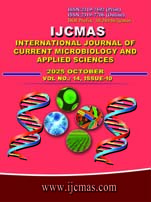


 National Academy of Agricultural Sciences (NAAS)
National Academy of Agricultural Sciences (NAAS)

|
PRINT ISSN : 2319-7692
Online ISSN : 2319-7706 Issues : 12 per year Publisher : Excellent Publishers Email : editorijcmas@gmail.com / submit@ijcmas.com Editor-in-chief: Dr.M.Prakash Index Copernicus ICV 2018: 95.39 NAAS RATING 2020: 5.38 |
Prosthetic joint infections (PJI) represent a severe complication following arthroplasty, contributing significantly to patient morbidity and substantial healthcare expenditures. This study aimed to characterize the microbiological profile of prosthetic joint infections at a tertiary care hospital. A prospective evaluation was conducted on 66 in-patient samples from individuals admitted to the orthopedic department with a history of PJI between November 2024 and May 2025. Periprosthetic tissue samples were collected and processed according to standard microbiological protocols. Among 66 confirmed PJI cases, a culture positivity rate of 56% was observed. Gram-positive cocci were the predominant pathogens (n=25, 37.8%), including MSSA (n=5, 7.5%), MRSA (n=6, 9%), Staphylococcus other than S.aureus group SoSA (n=8, 12%), Streptococcus species (n=4, 6.06%), and Enterococcus species (n=2, 3.03%). Gram-negative bacilli accounted for 18.1% of infections (n=12), with Enterobacter cloacae complex (n=4, 6.06%), E. coli (n=3, 4.5%), P. aeruginosa (n=3, 4.5%), S. marcescens (n=1, 1.5%), and K. pneumoniae (n=1, 1.5%) being isolated. The findings of this study highlight the significant prevalence of both gram-positive cocci, particularly staphylococcal species, and gram-negative bacilli in prosthetic joint infections within our tertiary care setting. This detailed bacteriological profile is crucial for guiding empirical antibiotic therapy and developing targeted infection control strategies to improve patient outcomes and reduce the burden of PJI.
Rodríguez-Merchán, E.C.; Davidson, D.J.; Liddle, A.D. Recent Strategies to Combat Infections from Biofilm-Forming Bacteria on Orthopaedic Implants. Int. J. Mol. Sci. 2021, 22, 10243. https://doi.org/10.3390/ijms221910243
Moriarty, T.F.; Schlegel, U.; Perren, S.; Richards, R.G. Infection in fracture fixation: Can we influence infection rates through implant design? J. Mater. Sci. Mater. Med. 2010, 21, 1031–1035.
Filipovic, U.; Dahmane, R.G.; Ghannouchi, S.; Zore, A.; Bohinc, K. Bacterial adhesion on orthopedic implants. Adv. Colloid Interface Sci. 2020, 283, 102228.
Mottola, C.; Matias, C.S.; Mendes, J.J.; Melo-Cristino, J.; Tavares, L.; Cavaco-Silva, P.; Oliveira, M. Susceptibility patterns of Staphylococcus aureus biofilms in diabetic foot infections. BMC Microbiol. 2016, 16, 119.
Macia, M.D.; Rojo-Molinero, E.; Oliver, A. Antimicrobial susceptibility testing in biofilm-growing bacteria. Clin. Microbiol. Infect. 2014, 20, 981–990.
Nishimura, S.; Tsurumoto, T.; Yonekura, A.; Adachi, K.; Shindo, H. Antimicrobial susceptibility of Staphylococcus aureus and Staphylococcus epidermidis biofilms isolated from infected total hip arthroplasty cases. J. Orthop. Sci 2006, 11, 46–50.
Dragosloveanu S, Birlutiu RM, Neamtu B, Birlutiu V. Microbiological Profiles, Antibiotic Susceptibility Patterns and the Role of Multidrug-Resistant Organisms in Patients Diagnosed with Periprosthetic Joint Infection over 8 Years: Results from a Single-Center Observational Cohort Study from Romania. Microorganisms. 2025 May 21; 13(5):1168. https://doi.org/10.3390/microorganisms13051168.
Boyle KK, Wood S, Tarity TD. Low-Virulence Organisms and Periprosthetic Joint Infection-Biofilm Considerations of These Organisms. Curr Rev Musculoskelet Med. 2018 Sep; 11(3): 409-419. https://doi.org/10.1007/s12178-018-9503-2 .
Hays MR, Kildow BJ, Hartman CW, Lyden ER, Springer BD, Fehring TK, Garvin KL. Increased Incidence of Methicillin-Resistant Staphylococcus aureus in Knee and Hip Prosthetic Joint Infection. J Arthroplasty. 2023 Jun; 38(6S):S326-S330. https://doi.org/10.1016/j.arth.2023.02.025.
Da Silva RB, Salles MJ. Outcomes and Risk Factors in Prosthetic Joint Infections by multidrug-resistant Gram-negative Bacteria: A Retrospective Cohort Study. Antibiotics (Basel). 2021 Mar 23; 10(3):340. https://doi.org/10.3390/antibiotics10030340.
Gómez-Junyent J, Lora-Tamayo J, Sorlí L, Murillo O. Challenges and strategies in the treatment of periprosthetic joint infection caused by multidrug-resistant Gram-negative bacteria: a narrative review. Clin Microbiol Infect. 2025 Jun 18:S1198-743X (25) 00302-7. https://doi.org/10.1016/j.cmi.2025.06.015
Rodríguez-Pardo D, Pigrau C, Lora-Tamayo J, Soriano A, del Toro MD, Cobo J, Palomino J, Euba G, Riera M, Sánchez-Somolinos M, Benito N, Fernández-Sampedro M, Sorli L, Guio L, Iribarren JA, Baraia-Etxaburu JM, Ramos A, Bahamonde A, Flores-Sánchez X, Corona PS, Ariza J; REIPI Group for the Study of Prosthetic Infection. Gram-negative prosthetic joint infection: outcome of a debridement, antibiotics and implant retention approach. A large multicentre study. Clin Microbiol Infect. 2014 Nov; 20(11): O911-9. https://doi.org/10.1111/1469-0691.12649 |
 |
 |
 |
 |